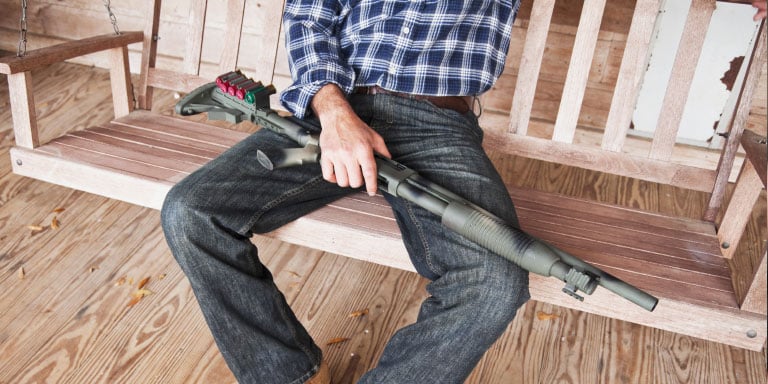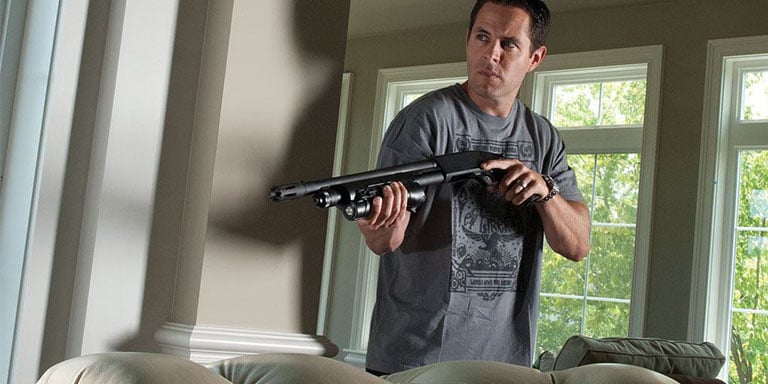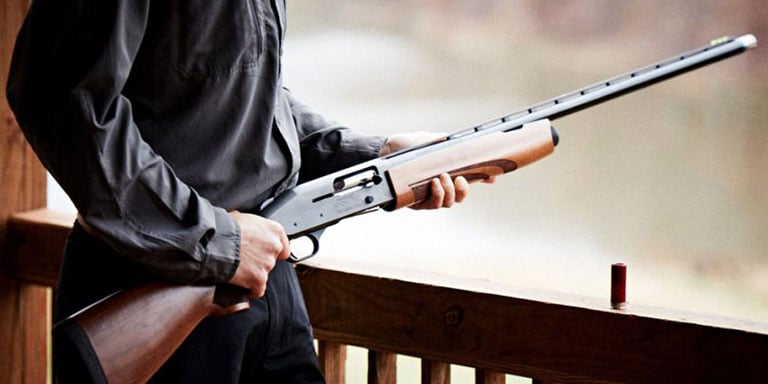Shotguns:

All types of firearms are well-suited to self-defense in certain situations and less ideal in others. Shotguns in particular have a reputation as ideal home-defense guns, and they certainly can be — but they aren’t quite as perfect and easy to use as they’re sometimes portrayed to be.
In this guide, we’ll lay out the major pros and cons of shotguns as home-defense weapons and compare them to pistols and rifles used for the same purpose.Shop Shooting Gear
Shotgun Pros and Cons: A Study in Extremes

Broadly speaking, shotguns tend to be very good at certain things and fairly poor at others. Of course, with enough practice, you can mitigate or eliminate almost any firearm’s drawbacks — just know that you will have to invest considerable time and effort to master the art of tactical shotgunning. By contrast, pistols and rifles tend to be somewhat easier for novice and intermediate shooters to use, and the gap between their advantages and disadvantages isn’t quite as wide.
Shotgun Strengths
Shotguns have clear advantages over pistols and rifles in several respects:
- Superior stopping power: 12-gauge buckshot and slugs hit hard; only the most gigantic pistol and rifle calibers can compare on a shot-for-shot basis. A typical #00 buckshot shell fires nine pellets, each of which impacts the target with roughly the speed and power of a .32 ACP round. Firing multiple projectiles dramatically increases your chances of hitting a vital area, and each pellet creates a separate wound. Very few attackers remain standing after a single, well-placed hit from a 12-gauge shotgun loaded with defense rounds.
- Projectile spread: In Hollywood, shotgun blasts produce basketball-sized wound patterns from only a few feet away and sometimes even hit multiple targets with a single shot. Shotgun pellets do spread, and this can be a tactical advantage at short range, but the extent of the spread is often greatly exaggerated. Between five and thirty yards, you can expect a spread of roughly 1inch per yard with most 12-gauge loads. So, at fifteen yards, the spread will be about 15 inches — roughly the width of an attacker’s torso.
- Intimidation factor: Any self-defense instructor or law enforcement officer worth their salt will tell you the most ideal resolution is one in which the attacker is apprehended with little or no resistance. Aside from the obvious concerns about the defender’s safety, the difference between a nonviolent resolution and one in which someone is hurt or killed is often the difference between spending a few hours at the police station versus 18 months in court. Shotguns have a certain visceral intimidation factor that pistols and rifles don’t have to quite the same degree. Some studies suggest that criminals and home invaders surrender or flee more often when they know that their prospective victim has a shotgun.
- Low penetration: Compared to pistol and rifle rounds, shotgun pellets are generally less likely to travel farther than you want them to. Even though they travel faster than most handgun rounds, they’re spherical as opposed to conical, which significantly reduces their ability to penetrate. Still, the wrong loads are more than capable of passing through the walls of your home and striking innocent bystanders, so it’s important to choose your ammo wisely. Several studies have found that #4 buckshot is powerful enough to stop most attackers in a single shot while being significantly less likely to penetrate a home’s exterior wall than #00 buckshot or slugs.
- Interruptible reloads: With pistols and rifles, reloading creates a moment — however brief — wherein you have only a single round in the chamber and ready to fire. Some such firearms have (arguably unnecessary) safety mechanisms that prevent the gun from firing with no magazine inserted, leaving you defenseless while reloading. Tube-fed shotguns, by contrast, can be reloaded whenever you have a spare moment without leaving the weapon incapable of firing the shells that are still in the tube.
Shotgun Weaknesses
Despite their awesome offensive capabilities, shotguns do have some significant drawbacks:
- Difficult to maneuver indoors: Shotguns, by U.S. law, are required to have barrels at least 18″ long, and most are 26″ or longer overall. This makes them much harder to maneuver dexterously in hallways or around corners. Regular training in long-gun home-defense techniques can mitigate this concern, as can obtaining an ATF-approved SBS (short-barreled shotgun) or AOW (any other weapon). However, both require a fair bit of paperwork and long waiting times before you can take the gun home. If you want to go this route, look for short shotguns classified as AOWs — the ATF fees are much lower than those associated with SBSs. Be aware, though, that a shorter barrel increases spread dramatically.
- Slow to engage multiple targets: Most shotguns have actions that must be cycled manually, resulting in fairly long delays between shots. This could be a real problem if your home is invaded by multiple assailants. You can master the art of firing a pump gun very quickly and accurately, but this takes considerable practice. Alternatively, you might consider purchasing a semi-automatic shotgun, but they tend to be quite expensive, often upwards of $1,500.
- Slow reloads and low ammo capacity: Tube-fed and break-action shotguns require shells to be loaded by hand, one at a time. In the case of the latter, continuous reloading is impossible, meaning that you’re vulnerable for several seconds while reloading. True shotgun masters can reload tube-fed models with amazing speed — even loading two or four shells at a time — but this skill requires many hours of practice and constant reinforcement. What’s more, the large size of 20, 12 and 10-gauge shotgun shells limits the number the weapon can hold — usually to about seven, at most. All that being said, these disadvantages, while real, are often overstated. The sheer power of a single 12 or 10-gauge shotgun shell is almost always enough to drop an attacker, whereas pistols and rifles often require multiple shots per target. Provided you aim (and time) your shots well, it’s very unlikely that you would need to reload your shotgun during a home-defense situation.
Other Reasons to Join the 12-Gauge Club

Increasing your mastery of shotguns has other, less obvious benefits, too.
- Most shotguns require more manual dexterity than pistols and rifles. Mastering the ability to quickly load, fire, cycle and unload a shotgun will make you much faster with your hands. These kinds of speed and hand-eye coordination translate well to other firearms and can be useful in a myriad of other situations as well.
- An excellent break or pump-action shotgun costs much less than a high-quality, semi-automatic pistol or rifle — sometimes one-third as much. Ammunition also tends to be cheaper, especially practice ammunition. General-purpose target loads are priced comparably to many pistol and rifle calibers, but you’ll typically fire fewer shotgun shells in a practice session than you would pistol or rifle rounds, bringing down the overall cost.
- Non-semi-automatic shotguns are mechanically simple and have few moving parts, making them easier to clean and less prone to malfunctions. Don’t forget to read up on the basics of gun cleaning and maintenance.
Shotguns Are the Ideal Home-Defense Weapon

Or rather, they can be with sufficient practice. Of course, the truly ideal home-defense weapon is whichever one you can fire quickly, accurately, and confidently, regardless of whether it’s a shotgun, pistol, or rifle. For more helpful resources on buying and shooting scatterguns, check out our guide on shotgun basics.
I found this article on tacticalgear.com and it is a great read.